Cross-Laminated Timber Floor: Analysis of the Acoustic Properties and Radiation Efficiency
Abstract
:1. Introduction
2. Materials and Methods
2.1. Acoustic and Vibration Parameters Determined from Measurements
2.2. Simulations and Analytical Models
3. Results and Discussion
3.1. Experimental Results: Sound Pressure Level-Derived Parameters
- 1.
- Starting from 315 Hz, there is an increasing trend with mass law R = 17.5lg(mf) − 50, so between 50 Hz and 315 Hz, the equation R = 17.5lg(m’) − 6.3 can be used (.93);
- 2.
- The trend of the mass law (Equation (11)) is significantly different from the theoretical one [70].
3.2. Experimental Results: Vibration-Derived Parameters
4. Comparison between Measured and Calculated Values
5. Conclusions
- Firstly, three different types of sources were used in the laboratory of the Free University of Bolzano: tapping machine, dodecahedron and rubber ball. Furthermore, vibration measurements were carried out for each source. The results make it possible to derive the impact sound pressure level obtained from the tapping machine and the rubber ball, the sound reduction index obtained with the dodecahedron, velocity levels and consequent radiation index for each of the sources. For all three sources, the use of velocity level measurements to derive the acoustic parameters has led to excellent results, in comparison to the experimental data. This is not a predictive method and could not be fully verified in in-situ measurements, due to lateral transmissions, which are not trivial, to be determined., As regards the measurement of the radiation index, it can be noted that at the frequency of 63 Hz, the higher value can be found in correspondence with the resonance frequency of the floor for each type of sound source. The same maximum can be found in the sound pressure measurements. Furthermore, the radiation indices of the two impact sources (tapping machine and rubber ball), at low frequency (50–80 Hz), provided results significantly similar, while after 80 Hz, the values of the tapping machine far exceed not only the radiation index of the rubber ball, but also that of the dodecahedron.
- Then, it was observed that the predicted sound reduction index, evaluated with the mass law R = 20lg(mf) − 47, was not suitable for the CLT floor examined, and a new proposed law was introduced for CLT floors. Furthermore, a correlation between the normalized impact pressure level and the impact sound pressure level of the rubber ball was detected.
- Finally, for all three types of sources, the use of velocity level measurements to derive the acoustic parameters has led to good results, in comparison to the experimental data. This could not be fully verified in in-situ measurements due to lateral transmissions, which are not trivial, to be determined.
Author Contributions
Funding
Institutional Review Board Statement
Informed Consent Statement
Acknowledgments
Conflicts of Interest
Appendix A
Appendix A.1. Tapping Machine Radiation Index Mapping
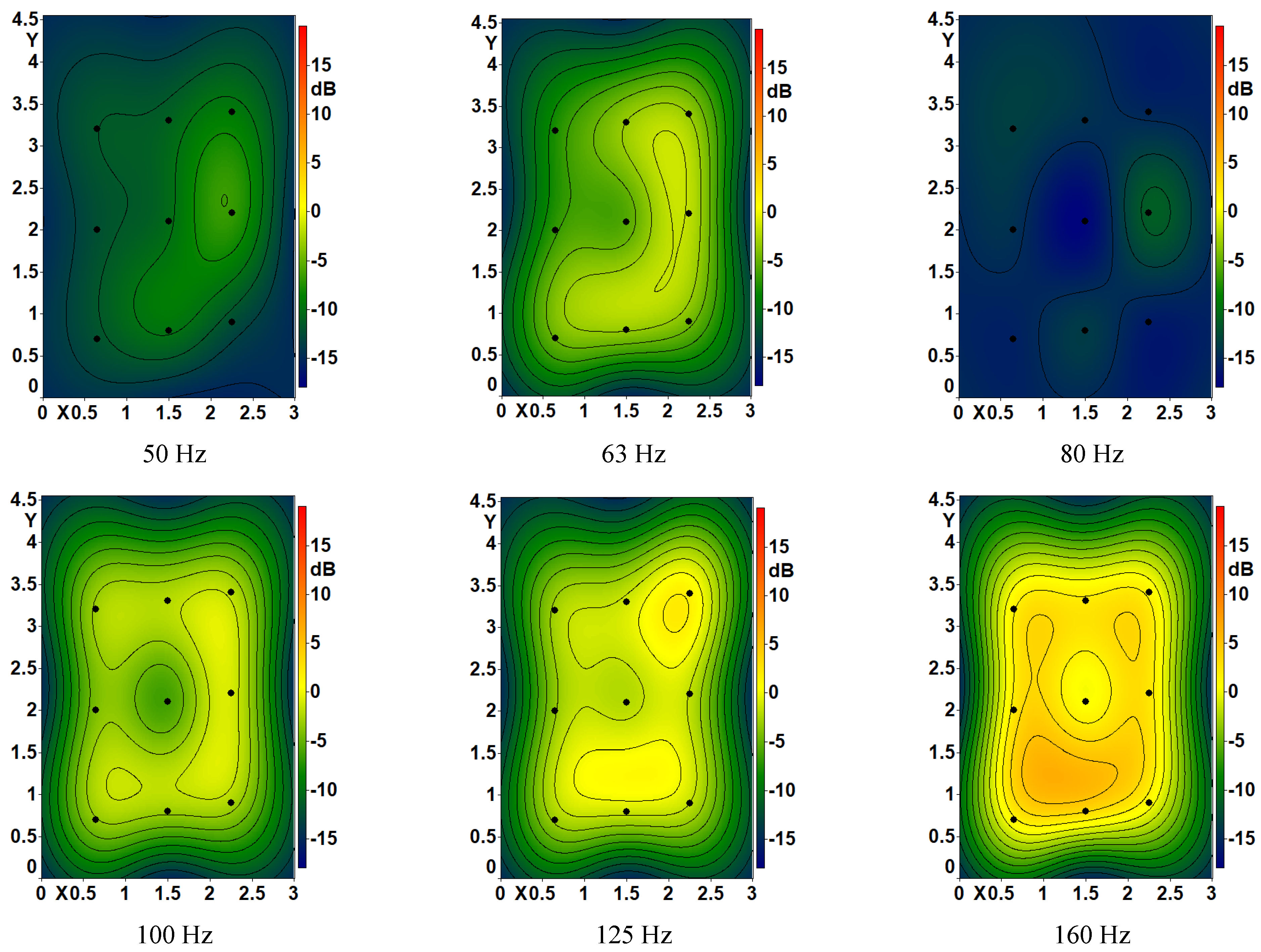

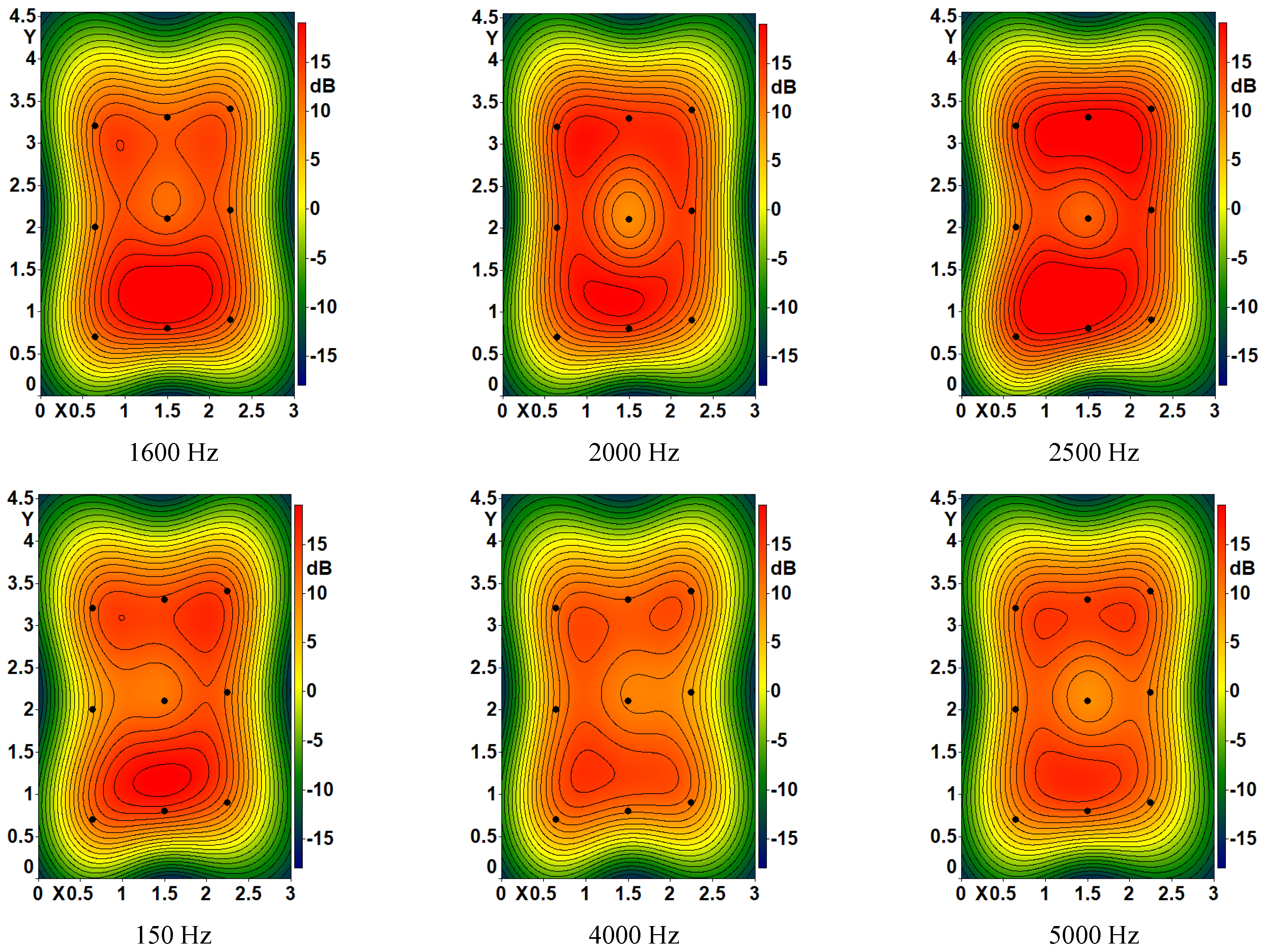
Appendix A.2. Airborne Noise Source Radiation Index Mapping
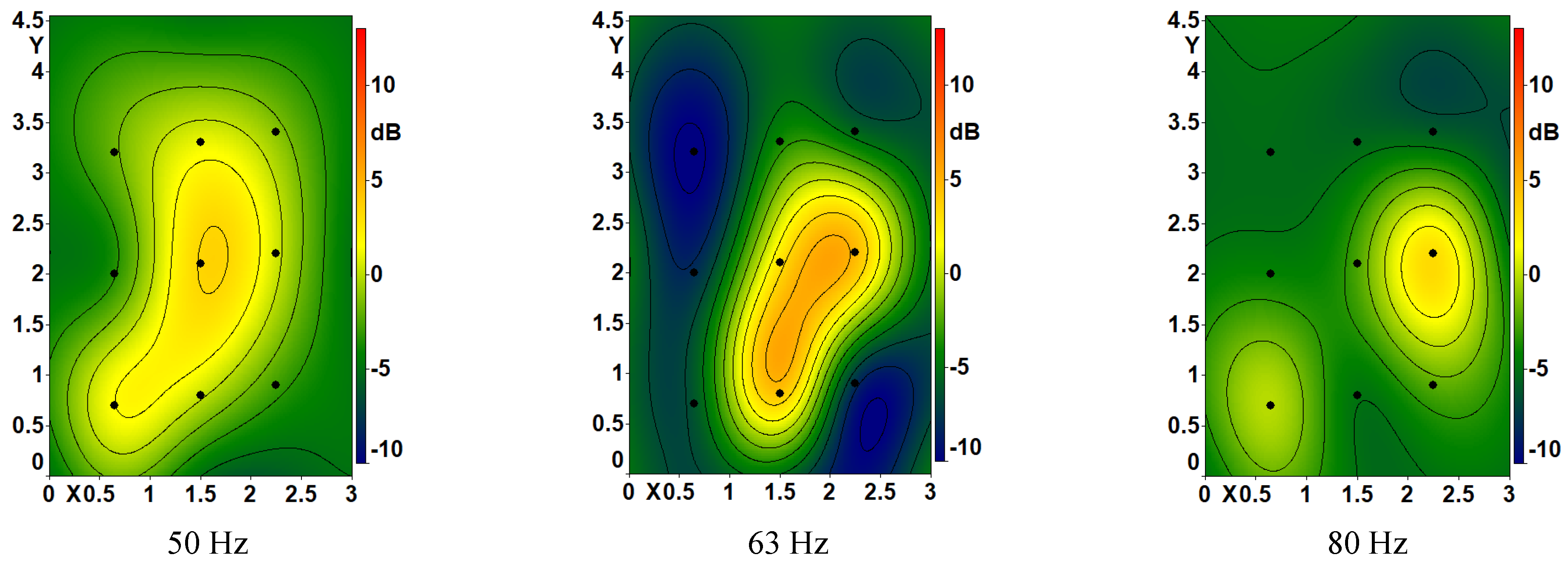


Appendix A.3. Rubber Ball Radiation Efficiency Mapping
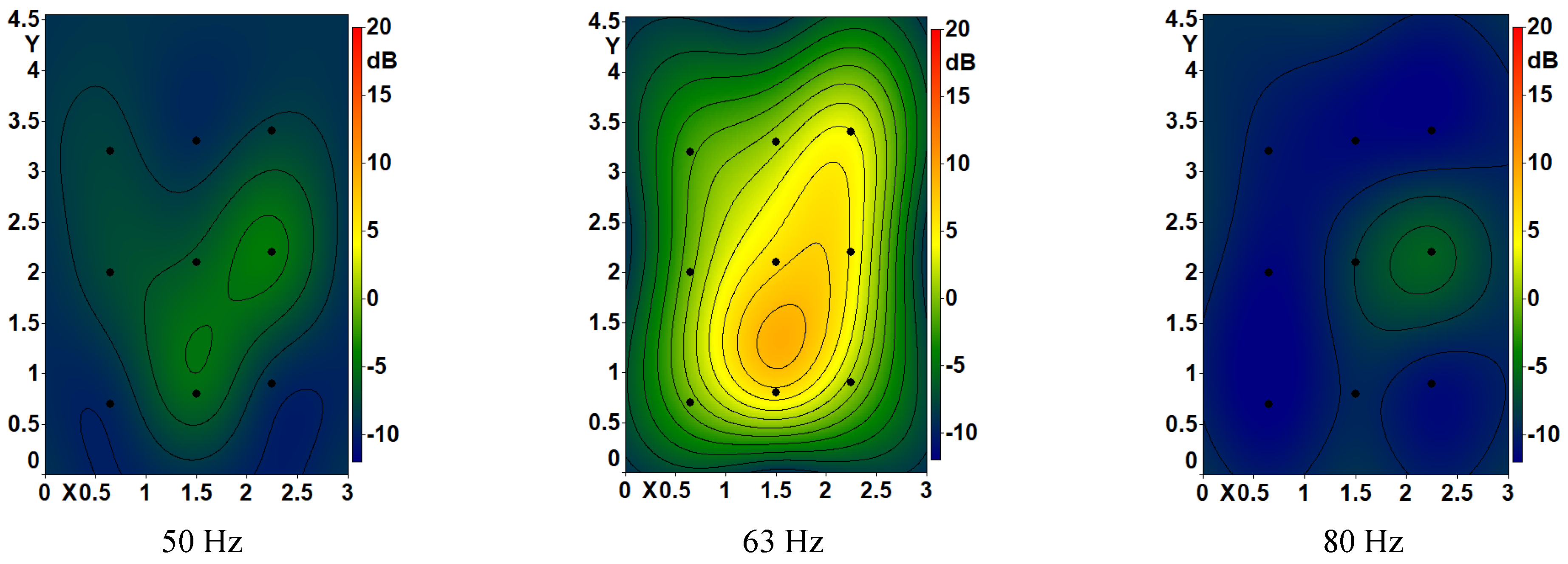
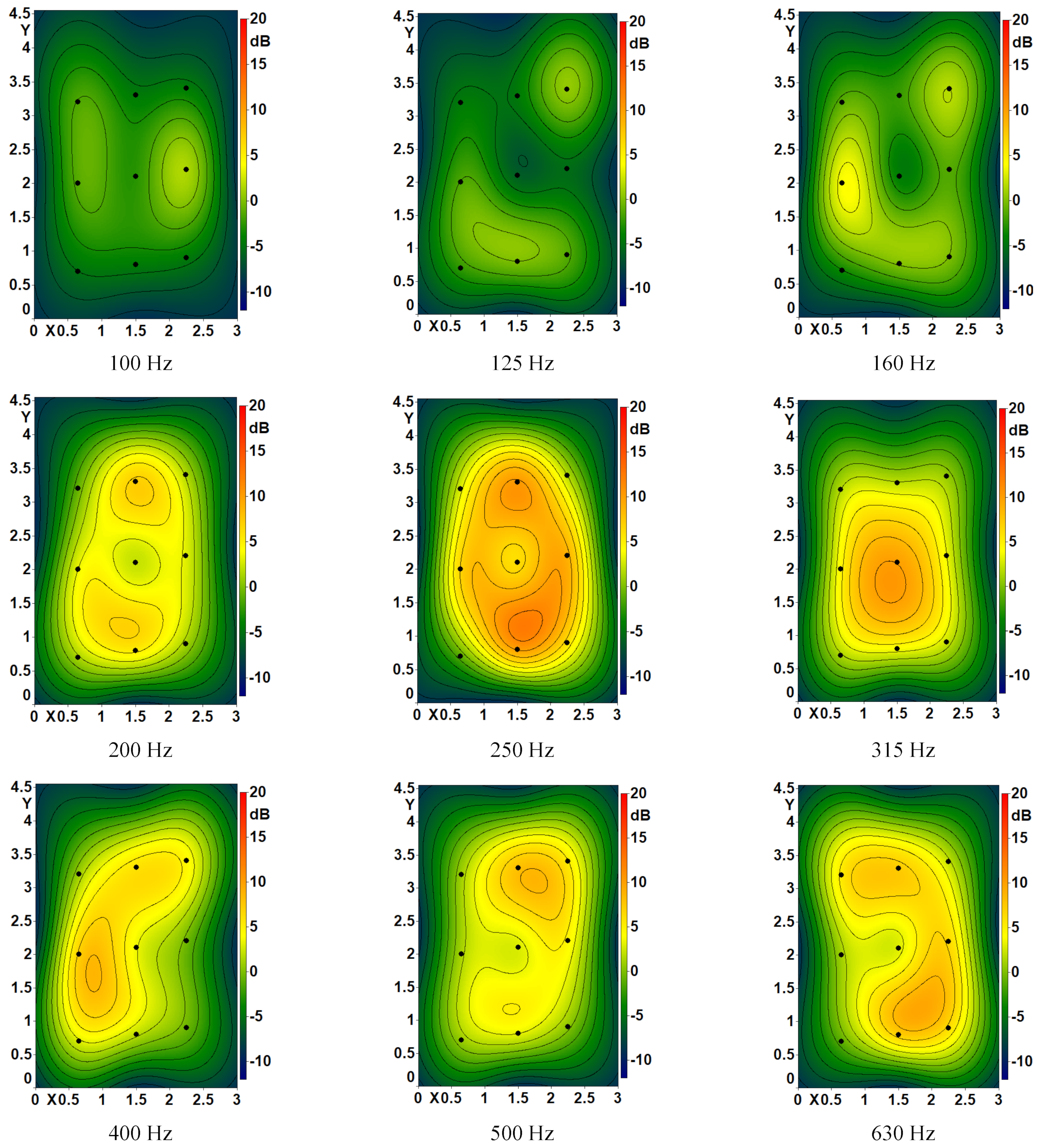
References
- Brandner, R.; Flatscher, G.; Ringhofer, A.; Schickhofer, G.; Thiel, A. Cross laminated timber (CLT): Overview and development. Eur. J. Wood Wood Prod. 2016, 74, 331–351. [Google Scholar] [CrossRef]
- Caniato, M.; Marzi, A.; da Silva, S.M.; Gasparella, A. A review of the thermal and acoustic properties of materials for timber building construction. J. Build. Eng. 2021, 43, 103066. [Google Scholar] [CrossRef]
- Caniato, M.; Cozzarini, L.; Schmid, C.; Gasparella, A. Acoustic and thermal characterization of a novel sustainable material incorporating recycled microplastic waste. Sustain. Mater. Technol. 2021, 28, e00274. [Google Scholar] [CrossRef]
- Brandner, R. Production and Technology of Cross Laminated Timber (CLT): A state-of-the-art Report. In Proceedings of the Focus Solid Timber Solutions-European Conference on Cross Laminated Timber (CLT), Graz, Austria, 21–22 May 2013; Volume 21, pp. 3–36. [Google Scholar]
- Öqvist, R.; Ljunggren, F.; Ågren, A. On the uncertainty of building acoustic measurements—Case study of a cross-laminated timber construction. Appl. Acoust. 2012, 73, 904–912. [Google Scholar] [CrossRef]
- Caniato, M.; Bettarello, F.; Ferluga, A.; Marsich, L.; Schmid, C.; Fausti, P. Thermal and acoustic performance expectations on timber buildings. Build. Acoust. 2017, 24, 219–237. [Google Scholar] [CrossRef]
- Caniato, M.; Bettarello, F.; Ferluga, A.; Marsich, L.; Schmid, C.; Fausti, P. Acoustic of lightweight timber buildings: A review. Renew. Sustain. Energy Rev. 2017, 80, 585–596. [Google Scholar] [CrossRef]
- Bettarello, F.; Caniato, M.; Scavuzzo, G.; Gasparella, A. Indoor Acoustic Requirements for Autism-Friendly Spaces. Appl. Sci. 2021, 11, 3942. [Google Scholar] [CrossRef]
- Hoeller, C.; Mahn, J.; Quirt, D.; Schoenwald, S.; Zeitler, B. Apparent sound insulation in cross-laminated timber buildings. J. Acoust. Soc. Am. 2017, 141, 3479. [Google Scholar] [CrossRef] [Green Version]
- Schoenwald, S.; Zeitler, B.; Sabourin, I.; King, F. Sound insulation performance of cross laminated timber building systems. In Proceedings of the INTER-NOISE and NOISE-CON Congress and Conference Proceedings, Innsbruck, Austria, 15–18 September 2013; Volume 247, pp. 4337–4346. [Google Scholar]
- Homb, A.; Guigou-Carter, C.; Rabold, A. Impact sound insulation of cross-laminated timber/massive wood floor constructions: Collection of laboratory measurements and result evaluation. Build. Acoust. 2017, 24, 35–52. [Google Scholar] [CrossRef]
- Zeitler, B.; Schoenwald, S.; Sabourin, I. Direct impact sound insulation of cross laminate timber floors with and without toppings. In Proceedings of the INTER-NOISE and NOISE-CON Congress and Conference Proceedings, Melbourne, Australia, 16–19 November 2014; Volume 249, pp. 5742–5747. [Google Scholar]
- Di Bella, A.; Granzotto, N.; Barbaresi, L. Analysis of acoustic behavior of bare CLT floors for the evaluation of impact sound insulation improvement. In Proceedings of the Meetings on Acoustics 22ICA, Buenos Aires, Argentina, 5–9 September 2016; Volume 28, p. 015016. [Google Scholar]
- Caniato, M.; Bettarello, F.; Fausti, P.; Ferluga, A.; Marsich, L.; Schmid, C. Impact sound of timber floors in sustainable buildings. Build. Environ. 2017, 120, 110–122. [Google Scholar] [CrossRef]
- Caniato, M.; Favretto, S.; Bettarello, F.; Schmid, C. Acoustic characterization of resonance wood. Acta Acust. United Acust. 2018, 104, 1030–1040. [Google Scholar] [CrossRef]
- Bettarello, F.; Gasparella, A.; Caniato, M. The Influence of Floor Layering on Airborne Sound Insulation and Impact Noise Reduction: A Study on Cross Laminated Timber (CLT) Structures. Appl. Sci. 2021, 11, 5938. [Google Scholar] [CrossRef]
- Barbaresi, L.; Morandi, F.; Garai, M.; Speranza, A. Experimental measurements of flanking transmission in CLT structures. In Proceedings of the Meetings on Acoustics 22ICA, Buenos Aires, Argentina, 5–9 September 2016; Volume 28, p. 015015. [Google Scholar]
- Zhang, X.; Hu, X.; Gong, H.; Zhang, J.; Lv, Z.; Hong, W. Experimental study on the impact sound insulation of cross laminated timber and timber-concrete composite floors. Appl. Acoust. 2020, 161, 107173. [Google Scholar] [CrossRef]
- Yang, Y.; Fenemore, C.; Kingan, M.J.; Mace, B.R. Analysis of the vibroacoustic characteristics of cross laminated timber panels using a wave and finite element method. J. Sound Vib. 2021, 494, 115842. [Google Scholar] [CrossRef]
- Kohrmann, M. Numerical Methods for the Vibro-Acoustic Assessment of Timber Floor Constructions; Technische Universität München: München, Germany, 2017. [Google Scholar]
- Jansson, L. Estimating Impact Noise through Cross Laminated Timber Floors Using the Transfer Matrix Method. In Proceedings of the INTER-NOISE 2021, Washington, DC, USA, 1–5 August 2021. [Google Scholar]
- ISO 12354-1:2017; Building Acoustics—Estimation of Acoustic Performance of Buildings from the Performance of Elements—Part 1: Airborne Sound Insulation between Rooms. International Organization for Standardization: Geneva, Switzerland, 2017.
- Caniato, M.; Schmid, C.; Gasparella, A. A comprehensive analysis of time influence on floating floors: Effects on acoustic performance and occupants’ comfort. Appl. Acoust. 2020, 166, 107339. [Google Scholar] [CrossRef]
- Atalla, N.; Nicolas, J. A new tool for predicting rapidly and rigorously the radiation efficiency of plate-like structures. J. Acoust. Soc. Am. 1994, 95, 3369–3378. [Google Scholar] [CrossRef]
- Nelisse, H.; Beslin, O.; Nicolas, J. A generalized approach for the acoustic radiation from a baffled or unbaffled plate with arbitrary boundary conditions, immersed in a light or heavy fluid. J. Sound Vib. 1998, 211, 207–225. [Google Scholar] [CrossRef]
- Foin, O.; Nicolas, J.; Atalla, N. An efficient tool for predicting the structural acoustic and vibration response of sandwich plates in light or heavy fluid. Appl. Acoust. 1999, 57, 213–242. [Google Scholar] [CrossRef]
- Hosseinkhani, A.; Younesian, D.; Krushynska, A.O.; Ranjbar, M.; Scarpa, F. Full-gradient optimization of the vibroacoustic performance of (non-) auxetic sandwich panels. Transp. Porous Media 2021, 1–18. [Google Scholar] [CrossRef]
- Hosseinkhani, A.; Younesian, D.; Ranjbar, M.; Scarpa, F. Enhancement of the vibro-acoustic performance of anti-tetra-chiral auxetic sandwich panels using topologically optimized local resonators. Appl. Acoust. 2021, 177, 107930. [Google Scholar] [CrossRef]
- Mejdi, A.; Atalla, N. Dynamic and acoustic response of bidirectionally stiffened plates with eccentric stiffeners subject to airborne and structure-borne excitations. J. Sound Vib. 2010, 329, 4422–4439. [Google Scholar] [CrossRef]
- Legault, J.; Mejdi, A.; Atalla, N. Vibro-acoustic response of orthogonally stiffened panels: The effects of finite dimensions. J. Sound Vib. 2011, 330, 5928–5948. [Google Scholar] [CrossRef]
- Rhazi, D.; Atalla, N. Transfer matrix modeling of the vibroacoustic response of multi-materials structures under mechanical excitation. J. Sound Vib. 2010, 329, 2532–2546. [Google Scholar] [CrossRef]
- Caniato, M.; Bettarello, F.; Bonfiglio, P.; Gasparella, A. Extensive investigation of multiphysics approaches in simulation of complex periodic structures. Appl. Acoust. 2020, 166, 107356. [Google Scholar] [CrossRef]
- Fortini, M.; Granzotto, N.; Piana, E.A. Vibro-acoustic characterization of a composite structure featuring an innovative phenolic foam core. Appl. Sci. 2019, 9, 1276. [Google Scholar] [CrossRef] [Green Version]
- Wang, P.; Lombaert, G.; Reynders, E. Numerical prediction and experimental validation of impact sound radiation by timber joist floors. Appl. Acoust. 2020, 162, 107182. [Google Scholar] [CrossRef]
- Conta, S.; Homb, A. Sound radiation of hollow box timber floors under impact excitation: An experimental parameter study. Appl. Acoust. 2020, 161, 107190. [Google Scholar] [CrossRef]
- Coguenanff, C.; Guigou-Carter, C. Multi-Criteria Optimization of a Wood-Based Floor. In Proceedings of the 24th International Congress on Sound and Vibration, ICSV24, London, UK, 23–27 July 2017. [Google Scholar]
- Guigou-Carter, C.; Coguenanff, C. Prediction of the acoustic performance of lightweight wood-based floor. In Proceedings of the INTER-NOISE and NOISE-CON Congress and Conference Proceedings, Ottawa, ON, Canada, 23–26 August 2009. [Google Scholar]
- Coguenanff, C.; Guigou-Carter, C.; Späh, M. Lightweight Floor: Step by Step Comparisons between Measured and Simulated Quantities. In Proceedings of the 24th International Congress on Sound and Vibration, ICSV24, London, UK, 23–27 July 2017. [Google Scholar]
- Hiramitsu, A.; Tomita, R.; Susumu, H.; Sato, M. Floor Impact Sound Insulation of the Six-Story Wood-Frame Model Building. In Proceedings of the 23rd International Congress on Acoustics, Aachen, Germany, 9–13 September 2019; pp. 5007–5012. [Google Scholar]
- Hiramitsu, A.; Tsuchimoto, T.; Kurumada, S. Floor impact sound insulation and airborne sound insulation on CLT model building. In Proceedings of the INTER-NOISE and NOISE-CON Congress and Conference Proceedings, Chicago, IL, USA, 26–29 August 2018; pp. 5014–5022. [Google Scholar]
- Van Damme, B.; Schoenwald, S.; Blanco, M.A.; Zemp, A. Limitations to the use of homogenized material parameters of cross laminated timber plates for vibration and sound transmission modelling. In Proceedings of the 22nd International Congress on Sound and Vibration, Florence, Italy, 12–16 July 2015; pp. 12–16. [Google Scholar]
- Jayalath, A.; Navaratnam, S.; Gunawardena, T.; Mendis, P.; Aye, L. Airborne and impact sound performance of modern lightweight timber buildings in the Australian construction industry. Case Stud. Constr. Mater. 2021, 15, e00632. [Google Scholar] [CrossRef]
- Caniato, M.; Gasparella, A.; Bettarello, F.; Santoni, A.; Fausti, P.; Granzotto, N.; Bécot, F.-X.; Chevillotte, F.; Jaouen, L.; Borello, G.; et al. A reliability study concerning the acoustic simulations of timber elements for buildings. Constr. Build. Mater. 2021, 315, 125765. [Google Scholar] [CrossRef]
- ISO 10140-1:2021; Acoustics—Laboratory Measurement of Sound Insulation of Building Elements Application Rules for Specific Products. International Organization for Standardization: Geneva, Switzerland, 2021.
- ISO 10140-2:2021; Acoustics—Laboratory Measurement of Sound Insulation of Building Elements Measurement of Airborne Sound Insulation. International Organization for Standardization: Geneva, Switzerland, 2021.
- ISO 10140-3:2021; Acoustics—Laboratory Measurement of Sound Insulation of Building Elements—Part 3: Measurement of Impact Sound Insulation. International Organization for Standardization: Geneva, Switzerland, 2021.
- ISO 10140-4:2021; Acoustics—Laboratory Measurement of Sound Insulation of Building Elements—Part 4: Measurement Procedures and Requirements. International Organization for Standardization: Geneva, Switzerland, 2021.
- ISO 10140-5:2021; Acoustics—Laboratory Measurement of Sound Insulation of Building Elements—Part 5: Requirements for Test Facilities and Equipment. International Organization for Standardization: Geneva, Switzerland, 2021.
- Caniato, M.; Bettarello, F.; Gasparella, A. Indoor and outdoor noise changes due to the COVID-19 lockdown and their effects on individuals’ expectations and preferences. Sci. Rep. 2021, 11, 16533. [Google Scholar] [CrossRef]
- Robinson, M.; Hopkins, C. Prediction of maximum fast time-weighted sound pressure levels due to transient excitation from the rubber ball and human footsteps. Build. Environ. 2015, 94, 810–820. [Google Scholar] [CrossRef]
- Caniato, M. Sound insulation of complex façades: A complete study combining different numerical approaches. Appl. Acoust. 2020, 169, 107484. [Google Scholar] [CrossRef]
- Jeon, J.Y.; Lee, P.J.; Sato, S. Use of the standard rubber ball as an impact source with heavyweight concrete floors. J. Acoust. Soc. Am. 2009, 126, 167–178. [Google Scholar] [CrossRef]
- Ryu, J.; Song, H.; Kim, Y. Effect of the suspended ceiling with low-frequency resonant panel absorber on heavyweight floor impact sound in the building. Build. Environ. 2018, 139, 1–7. [Google Scholar] [CrossRef]
- Shin, H.; Kim, K. Sound absorbing ceiling to reduce heavy weight floor impact sound. Build. Environ. 2020, 180, 107058. [Google Scholar] [CrossRef]
- Sato, H.; Yoshimura, J. Classification scheme of floor impact sounds with the standard rubber ball in dwellings. In Proceedings of the INTER-NOISE and NOISE-CON Congress and Conference Proceedings, Melbourne, VIC, Australia, 16–19 November 2014; Volume 249, pp. 6166–6172. [Google Scholar]
- Shen, X.; Hopkins, C. Prediction of Maximum Fast Time-Weighted Velocity Levels from a Rubber Ball Impact on a Timber Floor. In Proceedings of the Forum Acusticum, Lyon, France, 7–11 December 2020. [Google Scholar]
- Olsson, J.; Linderholt, A. Measurements of low frequency impact sound frequency response functions and vibrational properties of light weight timber floors utilizing the ISO rubber ball. Appl. Acoust. 2020, 166, 107313. [Google Scholar] [CrossRef]
- Jeong, J.H.; Kim, Y.H.; Ryu, J.K.; Kim, K.H. Just noticeable difference of rubber ball impact sound. In Proceedings of the Baltic-Nordic Acoustic Meeting, Reykjavík, Iceland, 15–18 April 2018. [Google Scholar]
- EN, B. 338 (2016). Available online: https://standards.iteh.ai/catalog/standards/cen/492c108d-268a-4cbd-9b59-3f31792887c5/en-338-2016 (accessed on 22 December 2021).
- Vér, I.L. Impact noise isolation of composite floors. J. Acoust. Soc. Am. 1971, 50, 1043–1050. [Google Scholar] [CrossRef]
- 61. ISO 717-2:2020; Acoustics—Rating of Sound Insulation in Buildings and of Building Elements—Part 2: Impact Sound Insulation. International Organization for Standardization: Geneva, Switzerland, 2021.
- ISO 717-1:2020; Acoustics—Rating of Sound Insulation in Buildings and of Building Elements—Part 1: Airborne Sound Insulation. International Organization for Standardization: Geneva, Switzerland, 2021.
- ISO 10848-1:2017; Acoustics—Laboratory and Field Measurement of Flanking Transmission for Airborne, Impact and Building Service Equipment Sound between Adjoining Rooms Frame Document. International Organization for Standardization: Geneva, Switzerland, 2017.
- Kristensen, J.; Rindel, J.H. Bygningsakustik: Teori og Praksis; Statens Byggeforskningsinstitut (SBI): Aalborg, Denmark, 1989. [Google Scholar]
- Sewell, E.C. Transmission of reverberant sound through a single-leaf partition surrounded by an infinite rigid baffle. J. Sound Vib. 1970, 12, 21–32. [Google Scholar] [CrossRef]
- Patrício, J.; da Silva, P.M.; da Piedade, A.C. The Influence of Concrete Elastic Characteristics on the Impact Noise Insulation of Concrete Floors. Build. Acoust. 1997, 4, 259–274. [Google Scholar] [CrossRef]
- Heckl, M.; Rathe, E.J. Relationship between the Transmission Loss and the Impact-Noise Isolation of Floor Structures. J. Acoust. Soc. Am. 1963, 35, 1825–1830. [Google Scholar] [CrossRef]
- Bettarello, F.; Fausti, P.; Baccan, V.; Caniato, M. Impact Sound Pressure Level Performances of Basic Beam Floor Structures. Build. Acoust. 2010, 17, 305–316. [Google Scholar] [CrossRef]
- Jeong, J.H.; Park, J.O. Repeatability Evaluation of Rubber Ball Impact Sound in a Reverberation Chamber. In Proceedings of the INTER-NOISE and NOISE-CON Congress and Conference Proceedings, Madrid, Spain, 16–19 June 2019. [Google Scholar]
- Fahy, F.J.; Gardonio, P. Sound and Structural Vibration: Radiation, Transmission and Response; Academic Press: Oxford, UK, 2006. [Google Scholar]
- ISO 12354-2:2017; Building Acoustics—Estimation of Acoustic Performance of Buildings from the Performance of Elements Impact Sound Insulation between Rooms. International Organization for Standardization: Geneva, Switzerland, 2017.





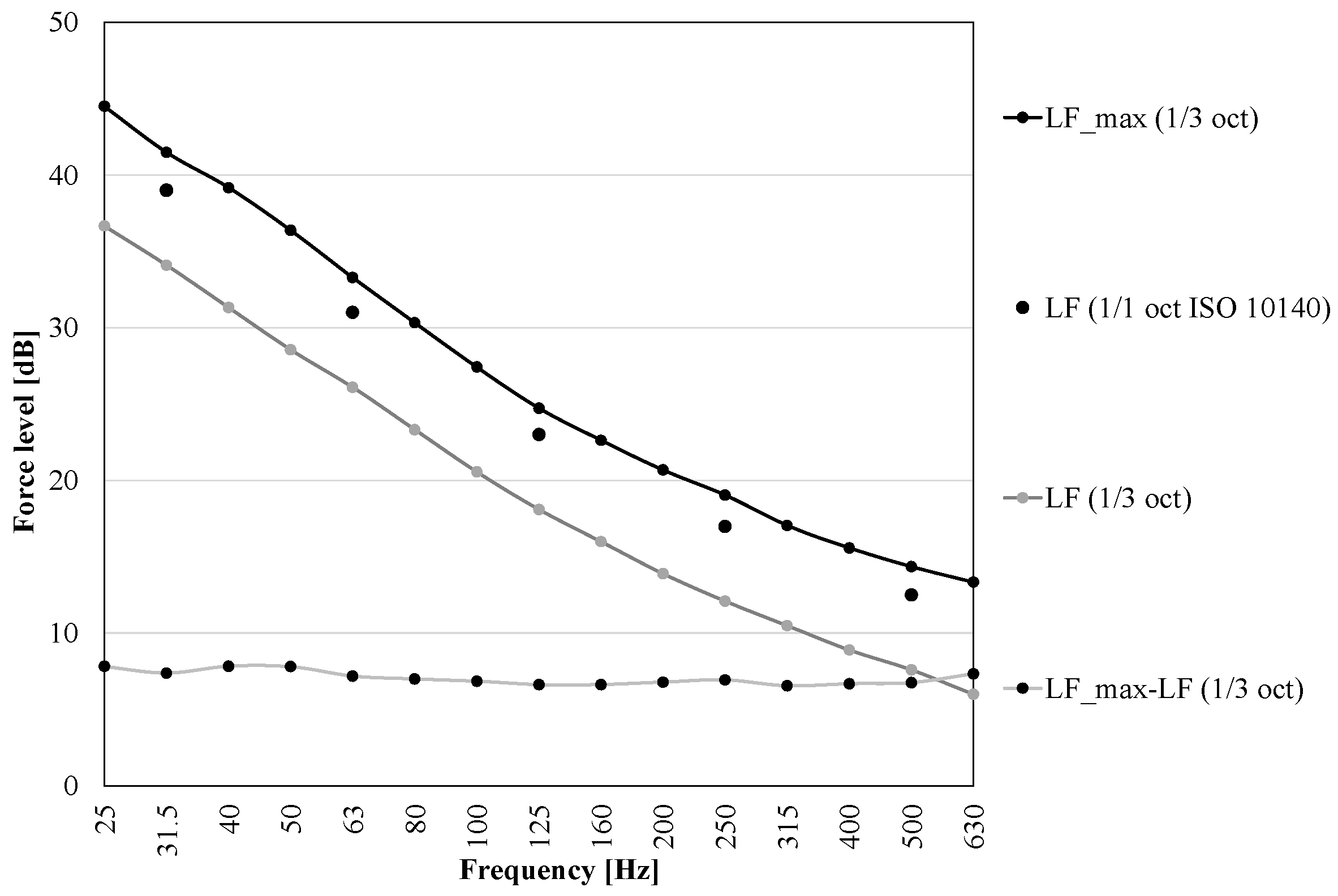


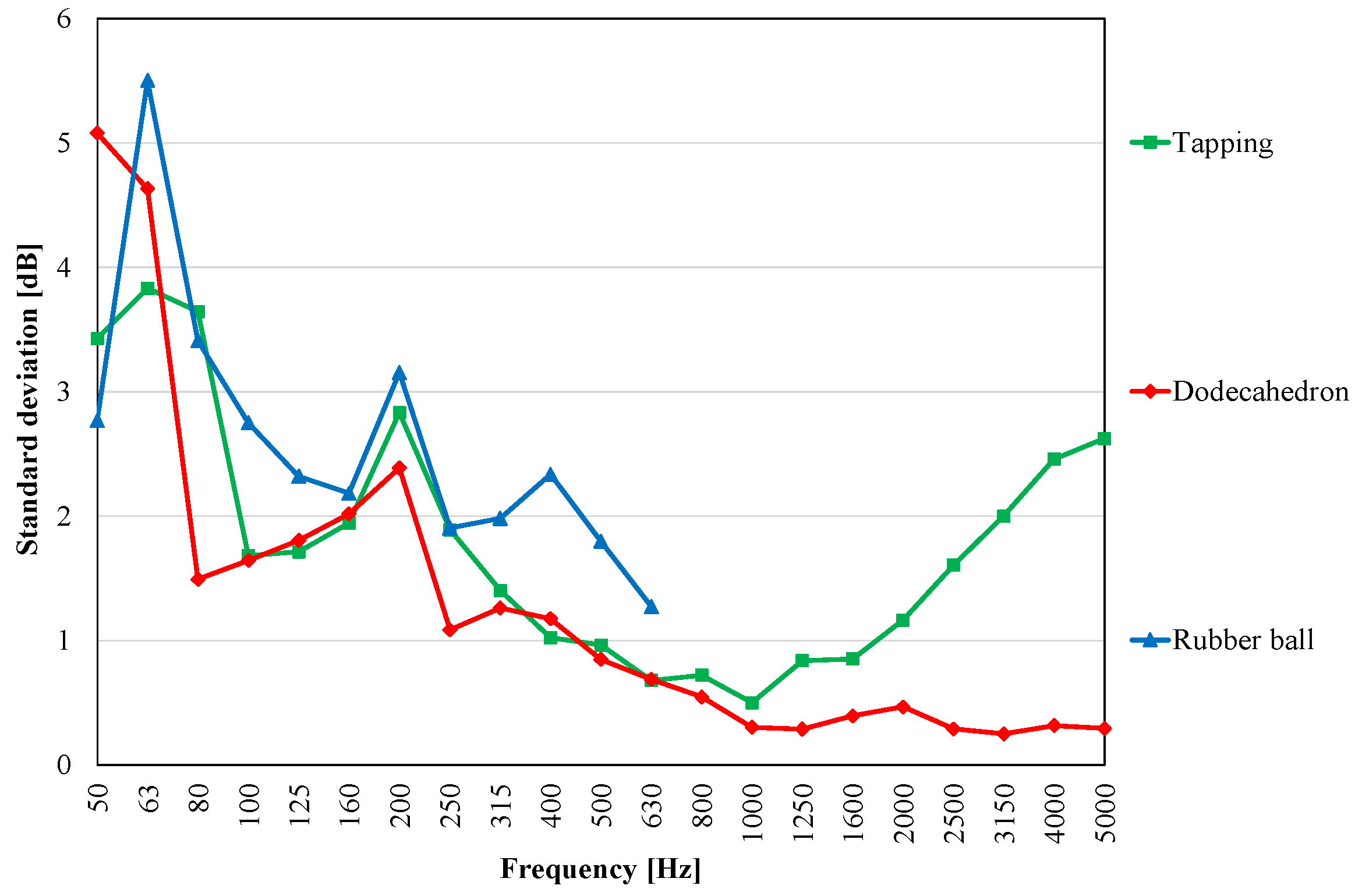
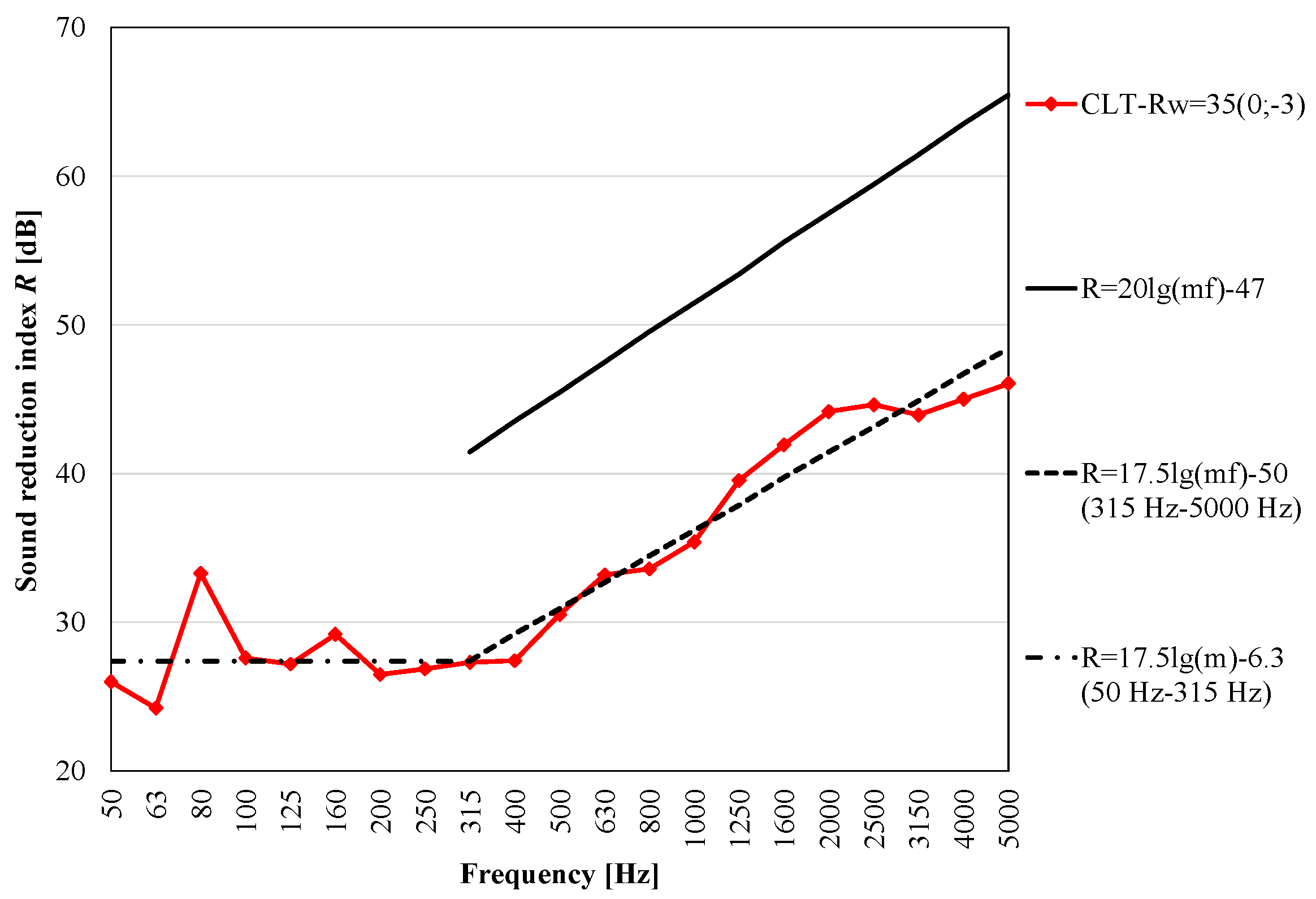

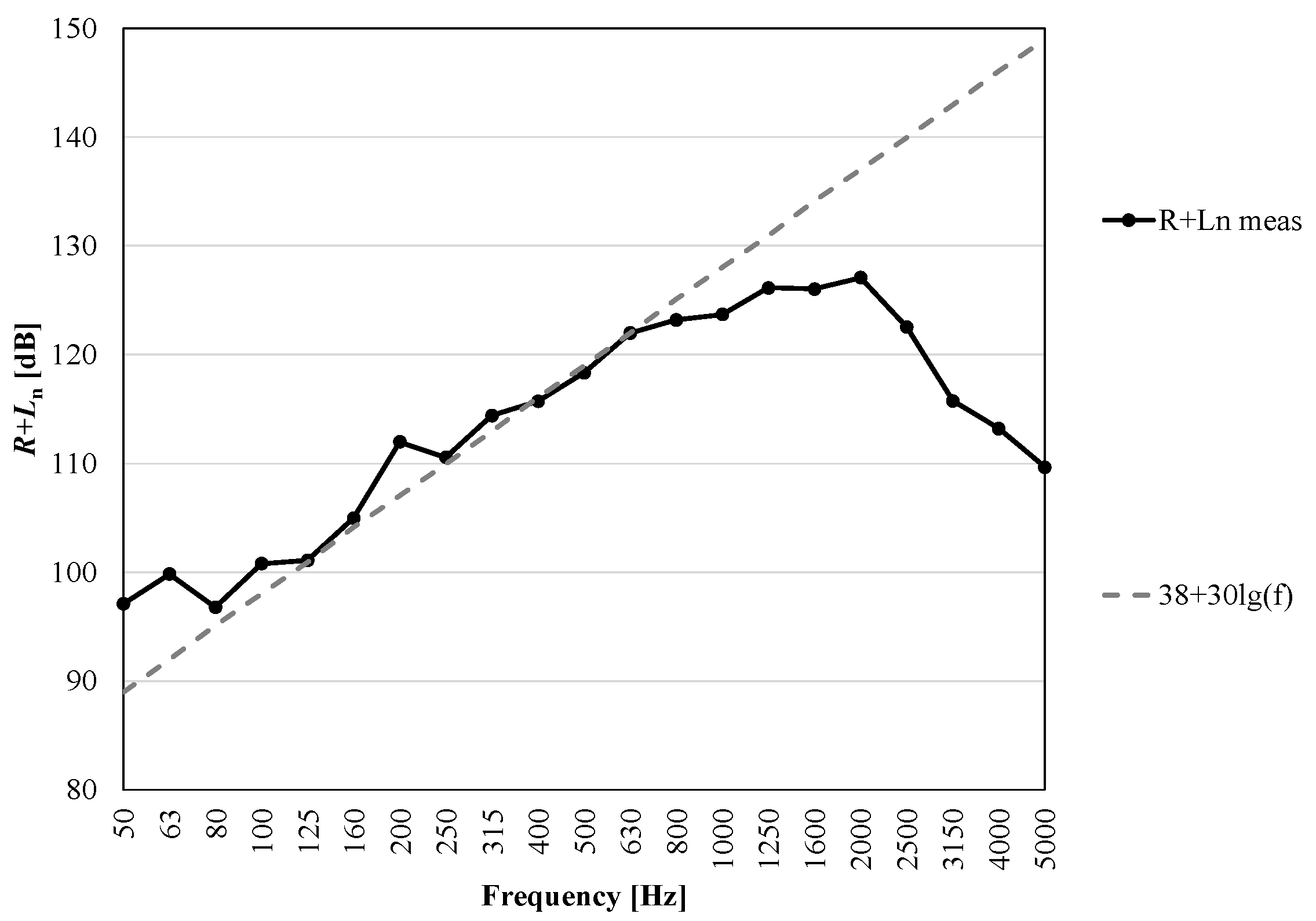

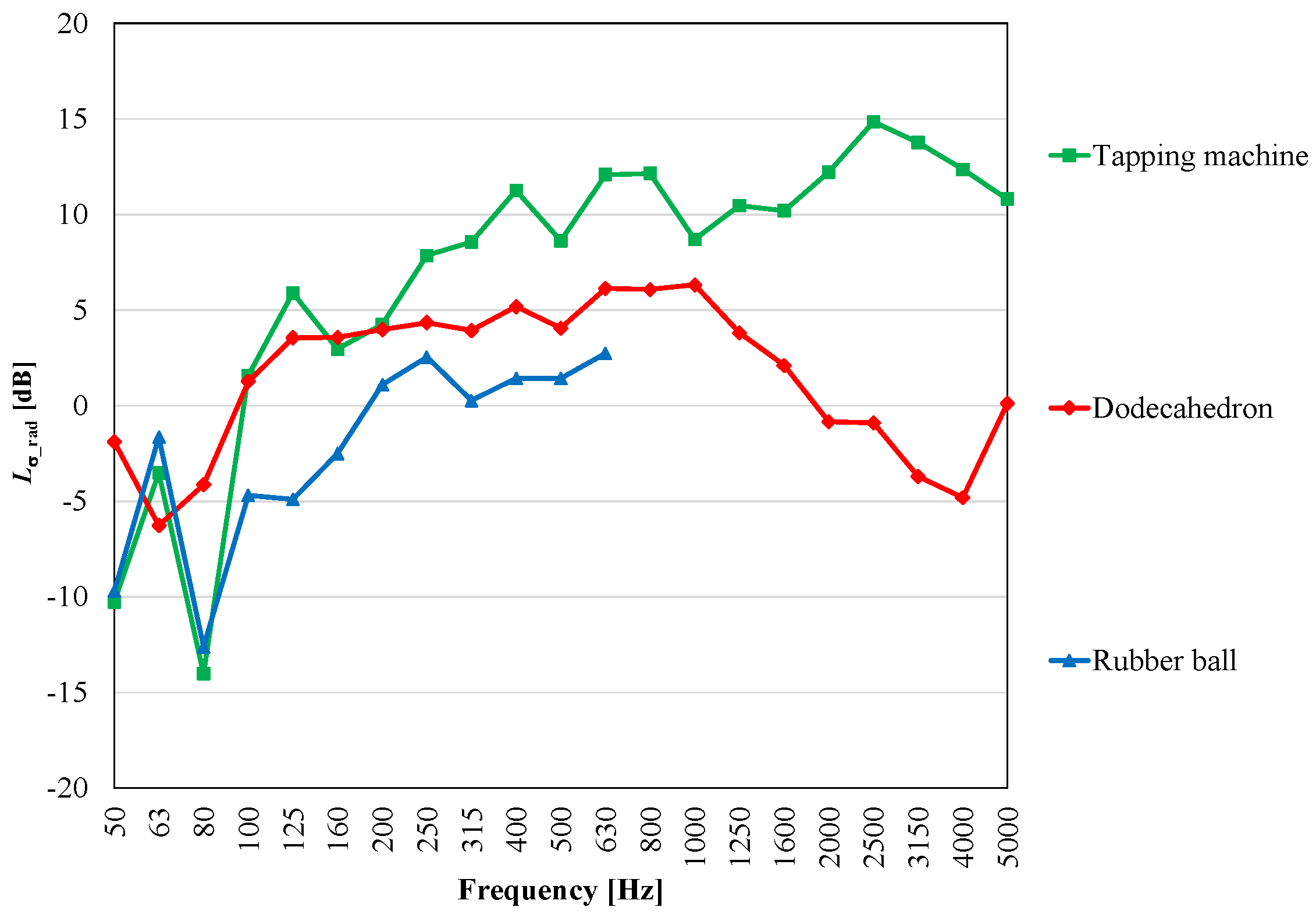

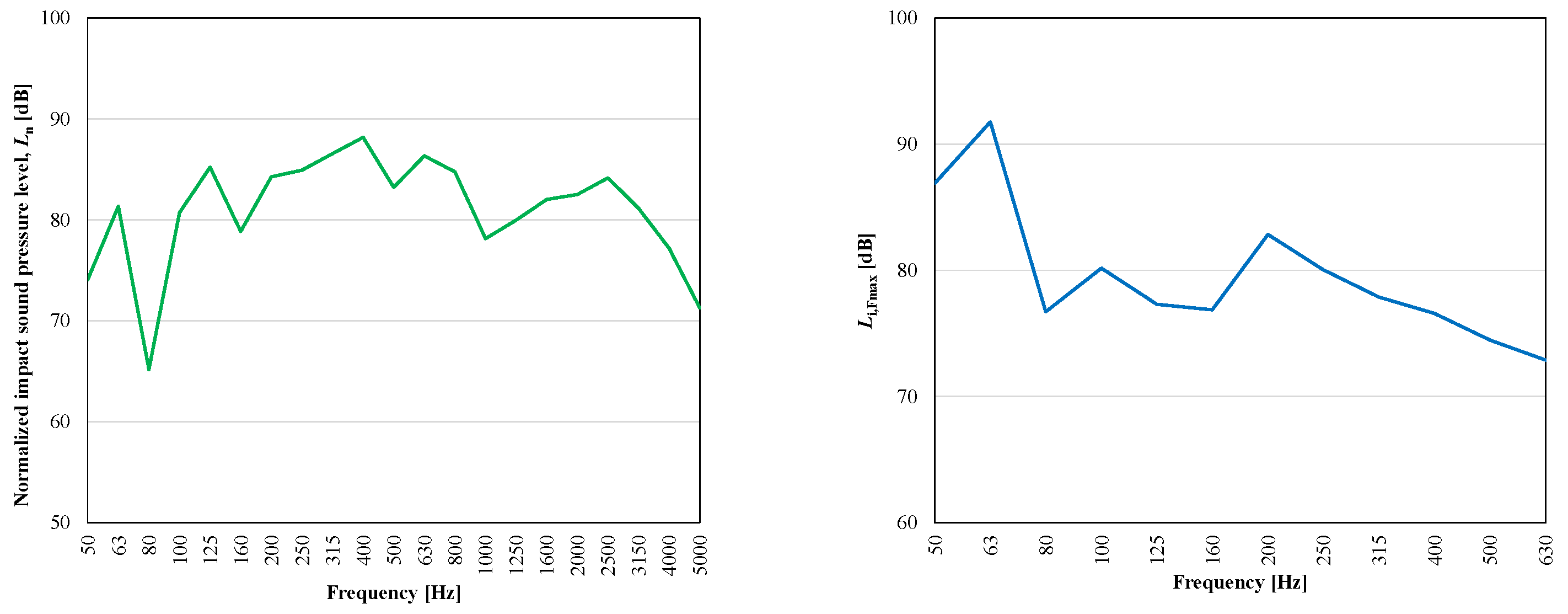
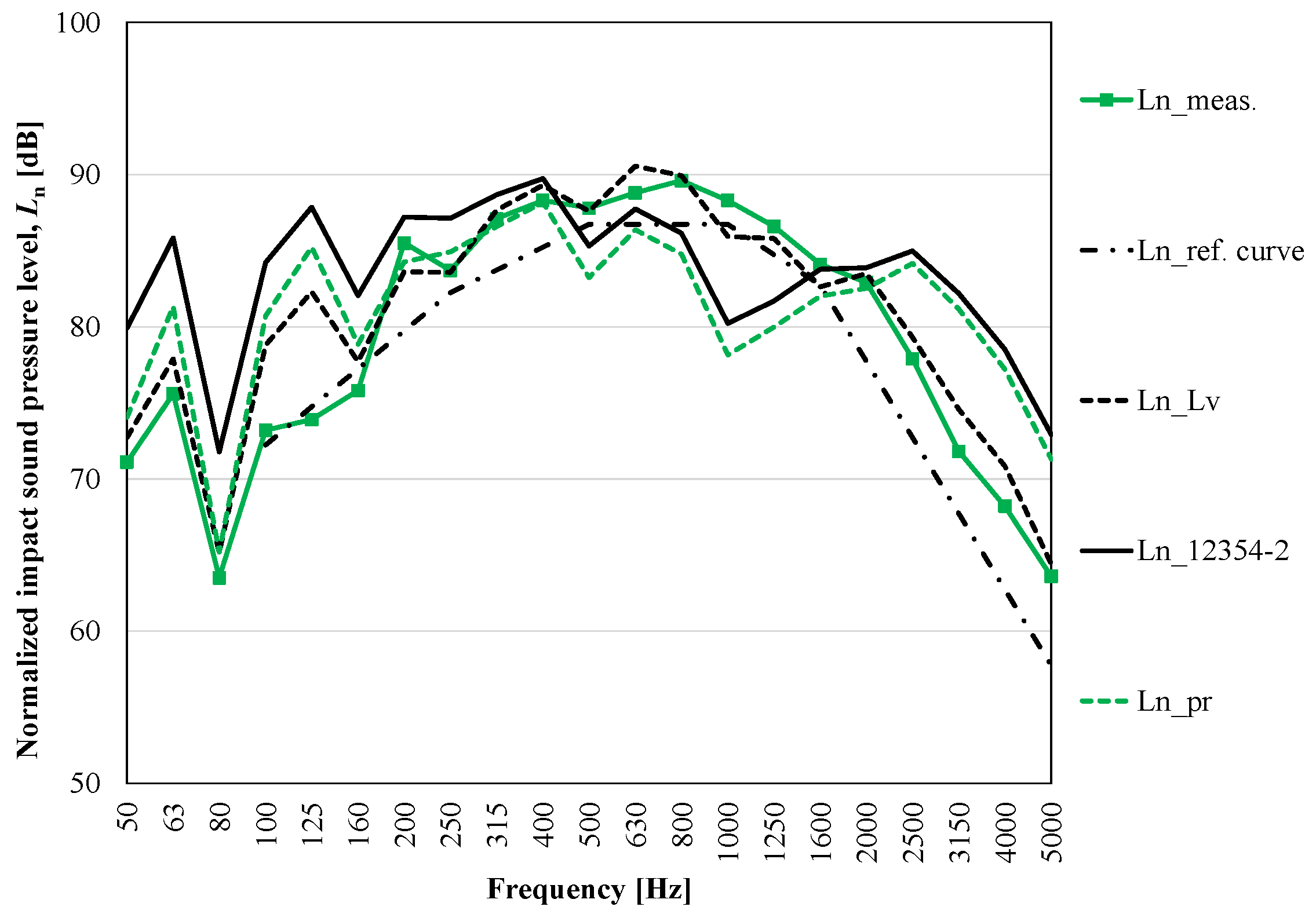
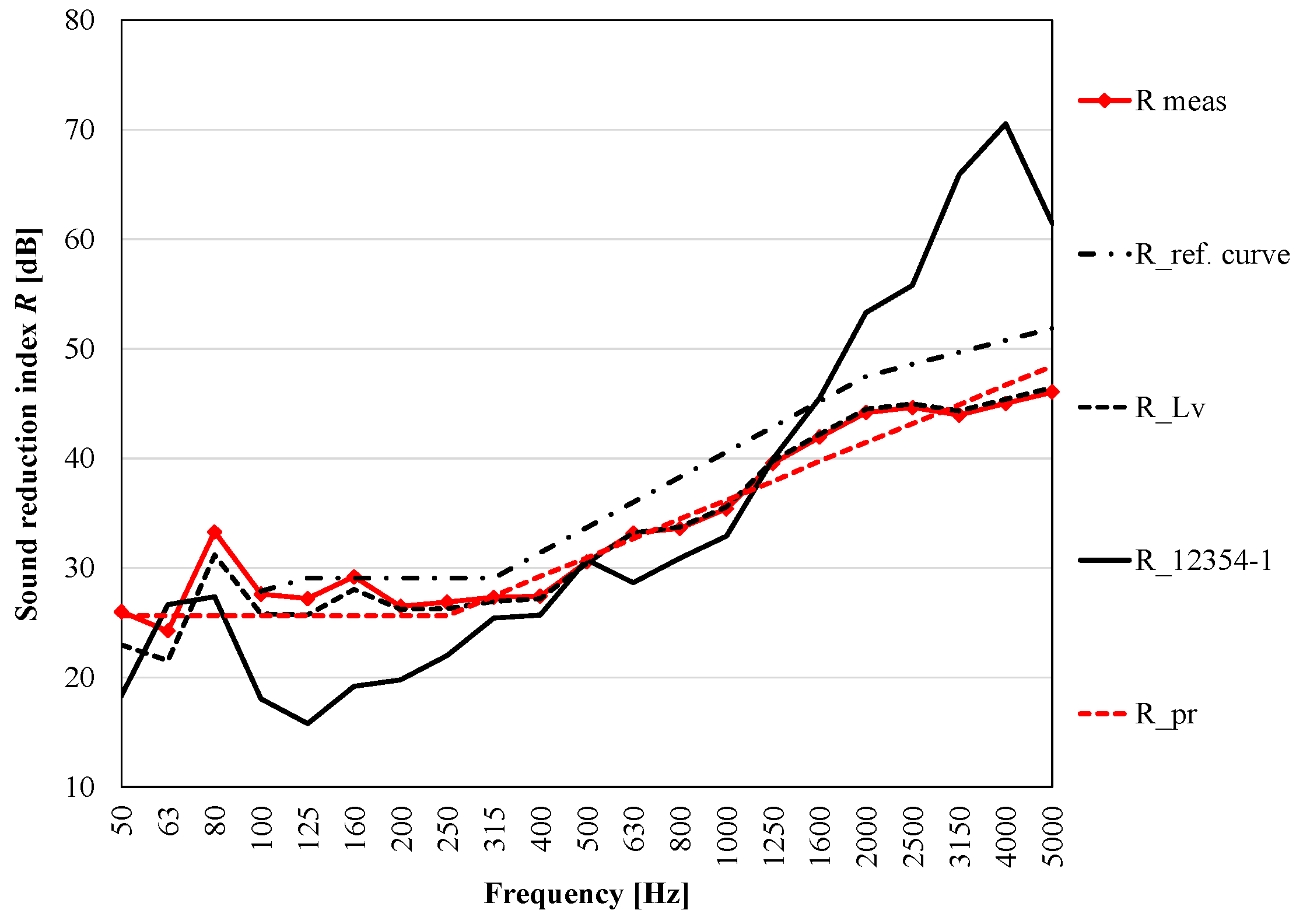
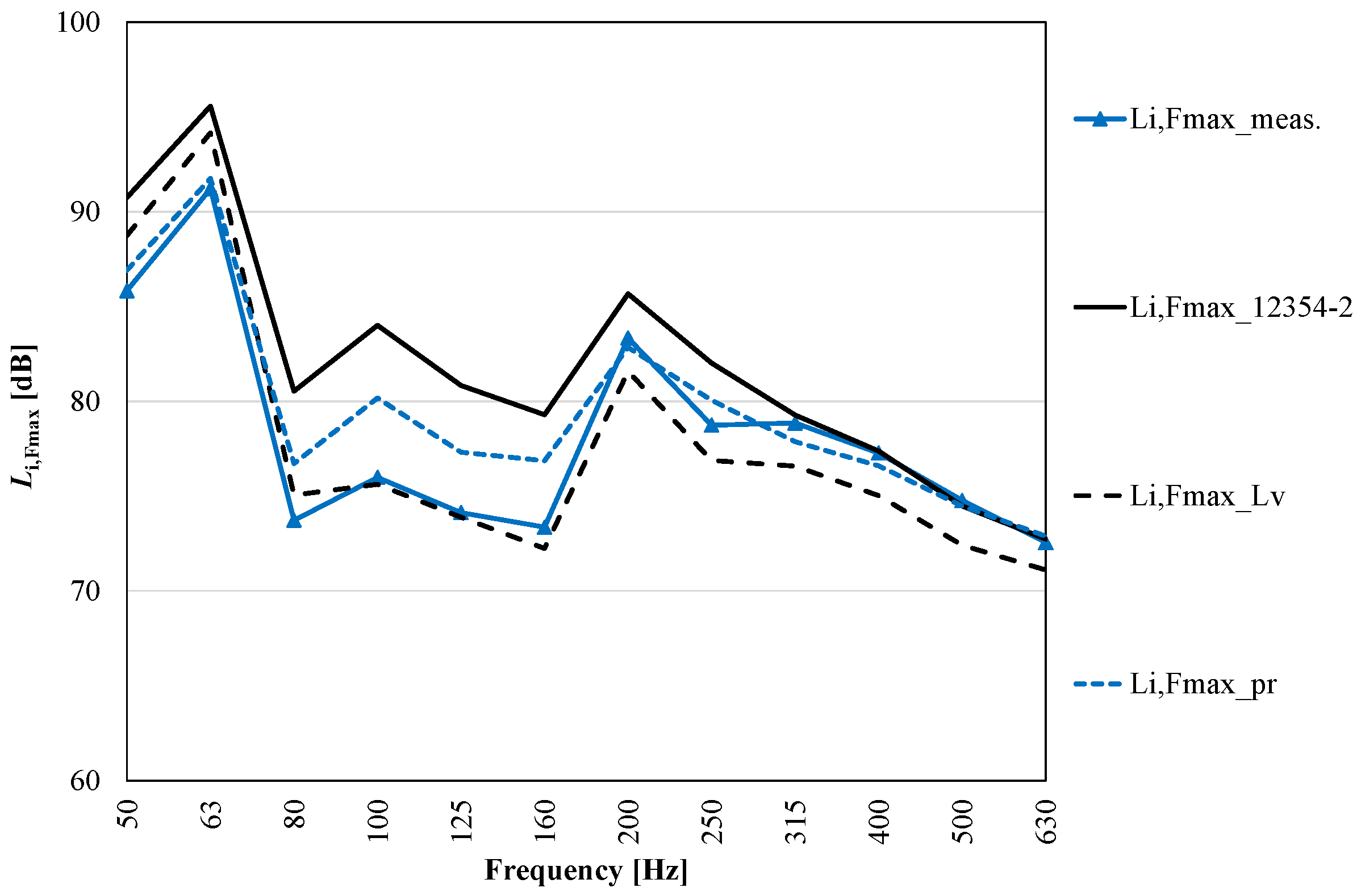
| Em,0,mean | Em,90,mean | ρmean | m’ |
|---|---|---|---|
| 11 kN/mm2 | 0.37 kN/mm2 | 420 kg/m3 | 84 kg/m2 |
| 1/1 Oct. Band Freq. [Hz] | 31.5 | 63 | 125 | 250 | 500 |
|---|---|---|---|---|---|
| Impact force exposure level [dB re 1 N] | 39.0 ± 1.0 | 31.0 ± 1.5 | 23.0 ± 1.5 | 17.0 ± 2.0 | 12.5 ± 2.0 |
| Ln,w [dB] | Rw [dB] | LiA,Fmax [dB(A)] |
|---|---|---|
| 88 | 35 | 80 |
| Ln,w_meas [dB] | Ln,w_ref. curve [dB] | Ln,w_Lv [dB] | Ln,w_12354-2 [dB] | Ln,w_pr [dB] |
|---|---|---|---|---|
| 88 | 86 | 89 | 90 | 88 |
| Rw [dB] | Rw_ref. Curve [dB] | Rw_Lv [dB] | Rw_12354-1 [dB] | Rw_pr [dB] |
|---|---|---|---|---|
| 35(0; −3) | 39(−1; −4) | 35(0; −3) | 32(−1; −4) | 35(0; −3) |
| LiA,Fmax_meas [dB(A)] | LiA,Fmax_Lv [dB(A)] | LiA,Fmax_12354-2 [dB(A)] | LiA,Fmax_pr [dB(A)] |
|---|---|---|---|
| 80 | 78 | 81 | 80 |
Publisher’s Note: MDPI stays neutral with regard to jurisdictional claims in published maps and institutional affiliations. |
© 2022 by the authors. Licensee MDPI, Basel, Switzerland. This article is an open access article distributed under the terms and conditions of the Creative Commons Attribution (CC BY) license (https://creativecommons.org/licenses/by/4.0/).
Share and Cite
Granzotto, N.; Marzi, A.; Gasparella, A. Cross-Laminated Timber Floor: Analysis of the Acoustic Properties and Radiation Efficiency. Appl. Sci. 2022, 12, 3233. https://doi.org/10.3390/app12073233
Granzotto N, Marzi A, Gasparella A. Cross-Laminated Timber Floor: Analysis of the Acoustic Properties and Radiation Efficiency. Applied Sciences. 2022; 12(7):3233. https://doi.org/10.3390/app12073233
Chicago/Turabian StyleGranzotto, Nicola, Arianna Marzi, and Andrea Gasparella. 2022. "Cross-Laminated Timber Floor: Analysis of the Acoustic Properties and Radiation Efficiency" Applied Sciences 12, no. 7: 3233. https://doi.org/10.3390/app12073233
APA StyleGranzotto, N., Marzi, A., & Gasparella, A. (2022). Cross-Laminated Timber Floor: Analysis of the Acoustic Properties and Radiation Efficiency. Applied Sciences, 12(7), 3233. https://doi.org/10.3390/app12073233







